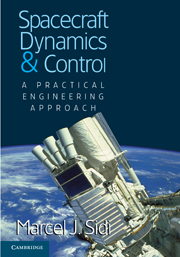Book contents
- Frontmatter
- Dedication
- Contents
- Preface
- Acknowledgments
- Chapter 1 Introduction
- Chapter 2 Orbit Dynamics
- Chapter 3 Orbital Maneuvers
- Chapter 4 Attitude Dynamics and Kinematics
- Chapter 5 Gravity Gradient Stabilization
- Chapter 6 Single- and Dual-Spin Stabilization
- Chapter 7 Attitude Maneuvers in Space
- Chapter 8 Momentum-Biased Attitude Stabilization
- Chapter 9 Reaction Thruster Attitude Control
- Chapter 10 Structural Dynamics and Liquid Sloshing
- Appendix A Attitude Transformations in Space
- Appendix B Attitude Determination Hardware
- Appendix C Orbit and Attitude Control Hardware
- Index
- References
Chapter 5 - Gravity Gradient Stabilization
Published online by Cambridge University Press: 18 December 2014
- Frontmatter
- Dedication
- Contents
- Preface
- Acknowledgments
- Chapter 1 Introduction
- Chapter 2 Orbit Dynamics
- Chapter 3 Orbital Maneuvers
- Chapter 4 Attitude Dynamics and Kinematics
- Chapter 5 Gravity Gradient Stabilization
- Chapter 6 Single- and Dual-Spin Stabilization
- Chapter 7 Attitude Maneuvers in Space
- Chapter 8 Momentum-Biased Attitude Stabilization
- Chapter 9 Reaction Thruster Attitude Control
- Chapter 10 Structural Dynamics and Liquid Sloshing
- Appendix A Attitude Transformations in Space
- Appendix B Attitude Determination Hardware
- Appendix C Orbit and Attitude Control Hardware
- Index
- References
Summary
Introduction
The present and remaining chapters deal with attitude control of spacecraft; this section serves as an introduction to all of them. The expression attitude control has the general meaning of controlling the attitude of the satellite. In practice, there exist a multitude of variations to this simple and apparently straightforward expression. The following are some examples of primary control tasks for which the attitude control system is responsible.
In orbital maneuvering and adjustments, the attitude of the satellite must be pointed and held in the desired ΔV direction.
A spin-stabilized satellite may be designed to keep the spin axis of its body pointed at some particular direction in space.
A nadir-pointing three-axis-stabilized satellite must keep its three Euler angles close to null relative to the orbit reference frame; this is true of most communications satellites.
In earth-surveying satellites, the attitude control system is designed to allow the operative payload to track defined targets on the earth's surface.
A scientific satellite observing the sky must maneuver its optical instruments toward different star targets on the celestial sphere in some prescribed pattern of angular motion.
The few examples listed and the many others not mentioned suggest a multitude of different tasks and missions to be performed by the attitude control system. However, we shall see that some features are common to all such systems.
An important distinction for attitude control concepts is between passive and active attitude control. Passive attitude control is attractive because the hardware required is less complicated and relatively inexpensive. Natural physical properties of the satellite and its environment are used to control the s/c attitude. However, the achievable accuracies with passive attitude control are generally much lower than those that are possible with active attitude control, which uses sophisticated (and much more expensive) control instrumentation.
Another important distinction is between attitude-maneuvering and nadir-pointing (earth-pointing) stabilized satellites.
- Type
- Chapter
- Information
- Spacecraft Dynamics and ControlA Practical Engineering Approach, pp. 112 - 131Publisher: Cambridge University PressPrint publication year: 1997

